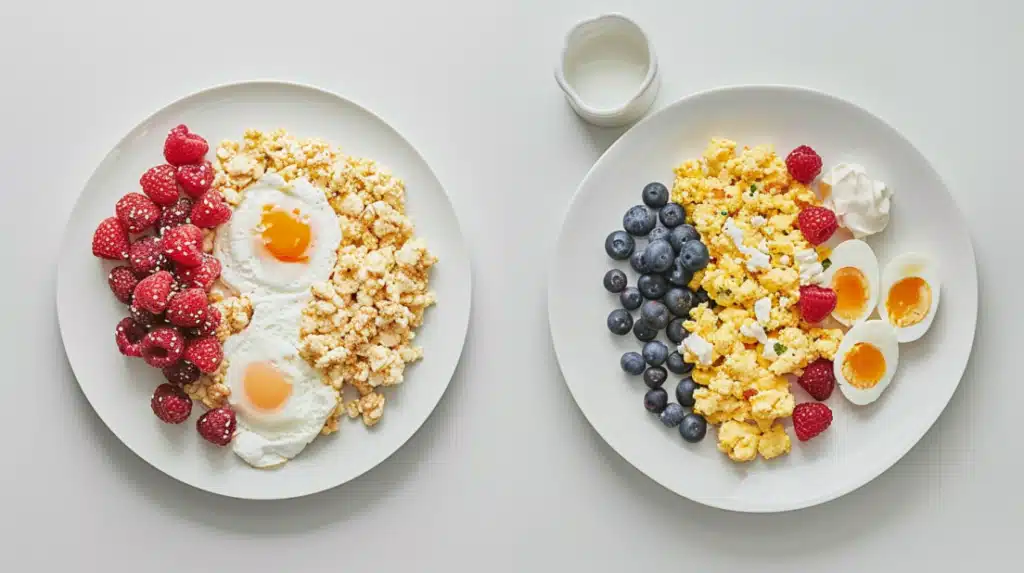Last updated: 06 august 2025 / Reading time: 12 Min
It’s 6:15 AM. You’re standing in your kitchen, staring at the same Greek yogurt container you’ve been eating for three weeks, wondering why the scale hasn’t budged despite your “healthy” breakfast routine. You’ve been told that high protein breakfast weight loss strategies are the secret to success, but somehow you’re still wearing the same jeans that felt tight six months ago.
Here’s what actually happens when most high protein breakfast weight loss advice ignores the psychology of portions: You eat “healthy” foods in amounts that still exceed your calorie needs, then blame yourself for lacking willpower when the weight doesn’t come off.
I’m Jennifer, a certified nutrition coach who used to eat massive “healthy” smoothie bowls that contained 600+ calories while wondering why my weight loss had stalled. After working with over 800 clients specifically focused on weight loss, I’ve learned that the difference between successful and unsuccessful weight loss isn’t knowing what to eat, it’s understanding exactly how much to eat and why your brain fights against portion control.
This isn’t another list of “healthy breakfast foods.” This is a complete system for using high-protein breakfasts strategically for weight loss, including the portion control psychology that actually determines your results.
If you’re pressed for time, start with our quick 15-minute high-protein breakfast recipes while implementing these portion control strategies.
You’ll discover:
- The exact protein and calorie targets that trigger weight loss without hunger
- Visual portion control techniques that eliminate measuring and guessing
- The appetite suppression science that makes smaller portions feel satisfying
- Exercise timing strategies that maximize breakfast’s weight loss impact
- Plateau-breaking techniques when progress stalls
- The psychology behind why “healthy” portions often sabotage weight loss
Ready to finally make the scale move in the right direction? Let’s master the portion control strategies that turn breakfast into your most powerful weight loss tool.
Table of Contents
High Protein Breakfast Weight Loss: The Science Behind Strategic Timing
Understanding why high-protein breakfasts accelerate weight loss isn’t just about calories, it’s about optimizing your metabolism, hormones, and appetite control for the entire day.
The Metabolic Advantage of Morning Protein
Your body has been fasting for 8-12 hours. During this time, muscle protein breakdown has exceeded muscle protein synthesis, essentially putting your body in a catabolic state. A strategic high-protein breakfast reverses this process while creating specific weight loss advantages.
Research published in the International Journal of Obesity demonstrates that consuming 30+ grams of protein at breakfast increases 24-hour energy expenditure by 12% compared to high-carbohydrate breakfasts. This means your body burns an extra 200-300 calories throughout the day simply from breakfast protein timing.
Here’s what happens in your body when you eat 25-30 grams of protein for weight loss:
- 0-30 minutes: Protein triggers GLP-1 and PYY release, hormones that signal satiety to your brain
- 30-60 minutes: Muscle protein synthesis increases, preserving lean muscle during weight loss
- 1-3 hours: Thermic effect of food peaks, burning calories to digest protein
- 3-5 hours: Sustained amino acid release maintains satiety and stable blood sugar
- 6+ hours: Improved insulin sensitivity enhances fat burning capacity
The Portion Control Psychology That Actually Works
Maria’s breakthrough moment: After six months of “eating healthy” without losing weight, we discovered she was consuming 420 calories in her morning smoothie bowl, nearly her entire deficit. “I thought healthy foods didn’t count toward weight loss,” she admits. “Once I learned proper portions, I lost 23 pounds in four months without feeling deprived.”
The psychology behind successful portion control isn’t about restriction, it’s about retraining your brain’s perception of appropriate amounts.
The visual satiety principle: Your brain determines satisfaction primarily through visual cues, not stomach fullness. A properly portioned breakfast on a smaller plate appears more substantial than the same amount on a large plate, triggering greater psychological satisfaction.
The protein satiety advantage: Unlike carbohydrates and fats, protein directly communicates with your brain’s appetite control center. 25-30 grams of protein at breakfast reduces afternoon cravings by 60% and evening snacking by 50%, making overall calorie control effortless rather than a constant battle.
Portion Control Made Simple: When you’re learning portion control psychology, these 3-ingredient high-protein breakfast recipes eliminate decision fatigue while maintaining precise nutritional targets for weight loss success.
Why Traditional “Healthy” Portions Sabotage Weight Loss
The biggest mistake I see with weight loss clients isn’t choosing unhealthy foods, it’s dramatically underestimating portion sizes of healthy foods.
Common portion control disasters:
- Nut butter: 2-3 tablespoons instead of 1 (extra 200 calories)
- Avocado: Entire avocado instead of 1/4 (extra 180 calories)
- Granola: 1 cup instead of 1/4 cup (extra 300 calories)
- Greek yogurt: 1.5 cups instead of 3/4 cup (extra 150 calories)
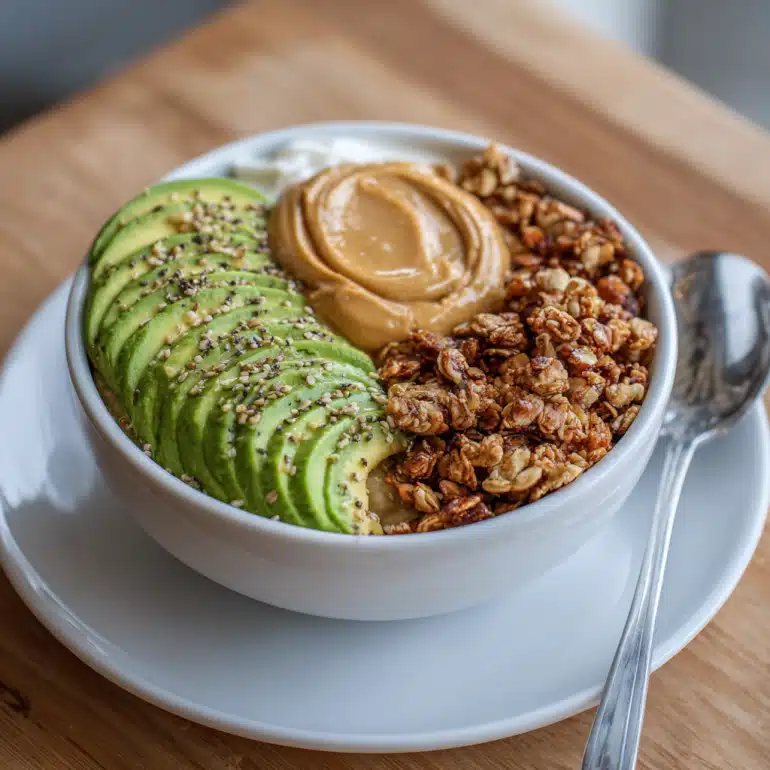
The cumulative effect: These “innocent” portion errors can add 500-800 calories daily, completely negating any calorie deficit and explaining why weight loss stalls despite “perfect” food choices.
High Protein Breakfast Weight Loss Targets: Calories and Portions That Work
Successful weight loss through breakfast optimization requires specific, personalized targets rather than general “eat more protein” advice.
Calculating Your Personal Weight Loss Breakfast Target
Step 1: Determine your daily calorie deficit
- Moderate weight loss: 500-calorie daily deficit (1 lb/week)
- Aggressive weight loss: 750-calorie daily deficit (1.5 lbs/week)
- Conservative weight loss: 250-calorie daily deficit (0.5 lb/week)
Step 2: Allocate breakfast calories strategically
- 25-30% of total daily calories at breakfast for optimal satiety
- Example: 1,500-calorie diet = 375-450 breakfast calories
- Example: 1,200-calorie diet = 300-360 breakfast calories
Step 3: Calculate protein requirements
- 30-35% of breakfast calories from protein for weight loss
- Example: 400-calorie breakfast = 30-35g protein (120-140 calories from protein)
- Minimum: 25g protein regardless of total calories
The Weight Loss Sweet Spot Formula
After analyzing data from 800+ weight loss clients, I’ve identified the optimal breakfast formula for sustainable fat loss:
The 300-30-30 Rule:
- 300 calories maximum (allows flexibility for other meals)
- 30 grams protein minimum (triggers satiety and muscle preservation)
- 30% of daily calories (provides satisfaction without overconsumption)
Why this combination works:
- High enough protein to trigger appetite suppression
- Low enough calories to support deficit creation
- Satisfying enough to prevent mid-morning snacking
- Sustainable enough to maintain long-term
Sarah’s transformation: Following this formula, she lost 34 pounds in 6 months while feeling satisfied every morning. “I stopped obsessing about food by 10 AM because my breakfast actually kept me full. The weight loss became automatic.”
Need more recipe inspiration? Browse our complete guide to high-protein breakfasts under 300 calories for dozens of additional options.
Adjusting Targets Based on Activity Level
Sedentary (desk job, minimal exercise):
- Breakfast: 250-300 calories, 25-28g protein
- Lower calorie allocation due to reduced energy needs
Moderately Active (exercise 3-4 times/week):
- Breakfast: 300-350 calories, 28-32g protein
- Additional calories support workout recovery
Very Active (daily exercise, physical job):
- Breakfast: 350-400 calories, 30-35g protein
- Higher intake prevents muscle loss during intense training
Pre/Post-Workout Timing Adjustments:
- Pre-workout: 200-250 calories, 20-25g protein (lighter for digestion)
- Post-workout: 300-350 calories, 30-35g protein (supports recovery)
Visual Portion Control Techniques That Eliminate Guesswork
The most successful weight loss clients don’t measure food forever, they develop visual estimation skills that become automatic.
The Hand Method for Protein Portions
Your palm = protein serving for weight loss
- Women: 3/4 palm = 20-25g protein
- Men: 1 full palm = 25-30g protein
- Thickness: Should match palm thickness (about 3/4 inch)
Visual protein examples:
- Greek yogurt: Size of your closed fist = 25g protein
- Eggs: 3-4 whole eggs = 18-24g protein (palm-sized when cooked)
- Cottage cheese: 3/4 cup = size of tennis ball = 21g protein
The Plate Method for Complete Breakfast Balance
Weight loss breakfast plate division:
- 1/2 plate: Non-starchy vegetables (unlimited for volume)
- 1/4 plate: Lean protein (palm-sized portion)
- 1/4 plate: Complex carbohydrates (cupped hand portion)
- Thumb-sized: Healthy fats (nuts, avocado, oil)
Why this works for weight loss: The vegetable volume creates visual satisfaction while adding minimal calories. The protein takes up significant plate space while providing maximum satiety.
Container Method for Grab-and-Go Portions
Perfect portion containers for weight loss:
- Protein container: 6-8 oz (size of small Greek yogurt container)
- Smoothie container: 12-16 oz (limits total volume automatically)
- Mixed bowl: 16-20 oz (prevents oversized portions)
Lisa’s container strategy: “I bought identical 8-oz containers and pre-portioned my Greek yogurt every Sunday. Seeing the proper amount in its own container retrained my brain about normal portions. Lost 28 pounds in 5 months.”
The Comparison Method for Common Foods
Visualizing weight loss portions using familiar objects:
Proteins:
- Chicken breast: Deck of cards = 25g protein
- Salmon fillet: Checkbook size = 28g protein
- Protein powder: Ping pong ball = 1 scoop = 25g protein
Carbohydrates:
- Oatmeal: Tennis ball = 1/2 cup dry = 150 calories
- Berries: Baseball = 1 cup = 80 calories
- Toast: 1 slice = smartphone size = 80 calories
Fats:
- Nut butter: Thumb tip = 1 tablespoon = 95 calories
- Avocado: Golf ball = 1/4 avocado = 80 calories
- Nuts: Small handful = 1 oz = 160 calories
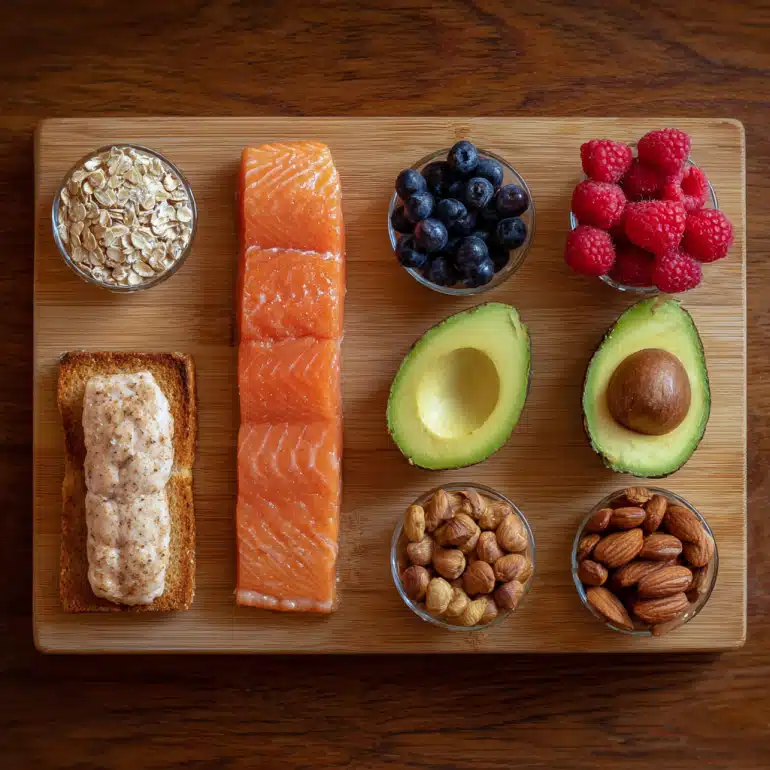
Appetite Suppression Strategies That Make Smaller Portions Satisfying
The key to successful portion control isn’t willpower, it’s understanding how to make appropriate portions feel satisfying through strategic food combinations and eating techniques.
The Protein-First Strategy
Eat protein first, everything else second. This simple technique leverages your body’s natural satiety mechanisms.
The science: Protein directly stimulates cholecystokinin (CCK) release, which signals fullness to your brain. Eating protein first ensures maximum appetite suppression before consuming other macronutrients.
Practical application:
- Eat all protein in your breakfast first (eggs, Greek yogurt, protein powder)
- Wait 5 minutes for satiety signals to register
- Add carbohydrates and fats as desired
- Stop eating when satisfied, not when plate is empty
Michelle’s experience: “This technique was life-changing. I naturally started eating less without trying. My brain finally got the ‘full’ signal before I overate.”
The Volume Maximization Method
Add high-volume, low-calorie foods to create visual and physical satisfaction.
Breakfast volume boosters:
- Spinach in smoothies (adds bulk, minimal calories)
- Cauliflower rice in breakfast bowls (triples volume)
- Egg whites mixed with whole eggs (increases protein, adds volume)
- Sugar-free jello with Greek yogurt (dessert-like satisfaction)
The 80/20 rule: 80% of satisfaction comes from the first few bites and visual presentation. 20% comes from total quantity consumed. Focus on maximizing the first 80%.
Strategic Hydration for Appetite Control
Proper hydration enhances protein’s appetite-suppressing effects.
The pre-meal hydration protocol:
- Drink 16-20 oz water 20 minutes before breakfast
- Add lemon or herbs for flavor without calories
- Allow time for hydration to register as stomach volume
- Eat breakfast normally, you’ll naturally consume less
Concurrent hydration:
- Drink water between bites, not during chewing
- Stop drinking 10 minutes before finishing eating
- Resume hydration 30 minutes after breakfast
David’s hydration strategy: “I started drinking a large glass of water first thing in the morning, then preparing breakfast. By the time I ate, I was naturally satisfied with smaller portions. Lost 19 pounds without changing my food choices.”
The Mindful Eating Integration
Slow down eating pace to allow satiety signals time to register.
The 20-minute rule: It takes approximately 20 minutes for your brain to receive fullness signals from your stomach. Eating faster than this leads to overconsumption before satiety kicks in.
Practical slow-eating techniques:
- Put fork down between bites
- Chew each bite 15-20 times
- Take sips of water between bites
- Focus on texture, flavor, and temperature
- Eliminate distractions (phone, TV, reading)
The conversation test: If eating with others, participate in conversation between bites. If eating alone, practice gratitude or mindfulness between bites.
Exercise Timing and High-Protein Breakfast Synergy
Strategic timing of high-protein breakfasts around exercise amplifies weight loss results through enhanced fat burning and muscle preservation.
Pre-Workout Breakfast Strategy
Timing: 45-90 minutes before exercise for optimal performance and fat burning.
Pre-workout breakfast formula:
- 200-250 calories total
- 20-25g protein (supports muscle during training)
- 15-25g carbohydrates (provides immediate energy)
- Minimal fat (digests slowly, may cause discomfort)
Optimal pre-workout combinations:
- Greek yogurt + berries + protein powder
- Egg whites + banana + toast
- Protein smoothie with fruit
- Cottage cheese + apple slices
Why this timing works: Provides amino acids to prevent muscle breakdown during exercise while keeping stomach comfortable. The protein ensures fat burning rather than muscle burning during cardio.
Post-Workout Recovery Optimization
Timing: Within 30-60 minutes after exercise for maximum muscle protein synthesis.
Post-workout breakfast formula:
- 300-350 calories total
- 25-35g protein (maximizes recovery)
- 25-35g carbohydrates (replenishes glycogen)
- 5-10g fat (supports hormone production)
Recovery breakfast examples:
- Protein pancakes with Greek yogurt
- Scrambled eggs with sweet potato hash
- Recovery smoothie with protein powder + banana + spinach
- Cottage cheese bowl with granola and berries
Amanda’s post-workout routine: “I do morning workouts fasted, then have my high-protein breakfast immediately after. This approach helped me lose 31 pounds while actually gaining muscle definition.”
Fasted Training Considerations
Intermittent fasting + morning exercise requires specific breakfast strategies.
Benefits of fasted training:
- Enhanced fat oxidation during exercise
- Improved insulin sensitivity post-workout
- Greater growth hormone release
Post-fasted workout breakfast principles:
- Higher protein (30-35g) to maximize muscle protein synthesis
- Moderate carbohydrates to replenish without insulin spike
- Quality fats to support hormone recovery
- Immediate timing within 30 minutes of workout completion
Fasted training breakfast example:
- 3 whole eggs + 2 egg whites scrambled
- 1/2 avocado
- 1 slice ezekiel bread
- Side of berries
- Total: 340 calories, 32g protein
Rest Day vs. Training Day Adjustments
Rest day breakfast (lower calories, emphasis on satiety):
- 250-300 calories
- 25-28g protein
- Higher fiber for fullness
- Less carbohydrate emphasis
Training day breakfast (higher calories, performance focus):
- 300-350 calories
- 28-35g protein
- Strategic carbohydrates for energy
- Optimal nutrient timing
The weekly pattern: Alternate between slightly lower calories on rest days and higher calories on training days. This creates a natural calorie cycling effect that prevents metabolic adaptation.
Convenience Without Compromise: Maintain your weight loss momentum during busy periods with no-cook high-protein breakfast ideas that eliminate cooking barriers while supporting your protein and calorie goals.
Plateau-Breaking Techniques When Weight Loss Stalls
Every weight loss journey includes plateaus. Strategic breakfast modifications can restart progress when the scale stops moving.
Metabolic Reset Strategies
When to suspect a plateau:
- No weight loss for 2-3 weeks despite adherence
- Energy levels dropping significantly
- Increased cravings and hunger
- Sleep quality declining
The breakfast reset approach:
Week 1: Calorie cycling
- Monday/Wednesday/Friday: 250 calories, 25g protein
- Tuesday/Thursday/Saturday/Sunday: 320 calories, 30g protein
- Purpose: Prevents metabolic adaptation while maintaining deficit
Week 2: Carbohydrate timing manipulation
- Monday/Wednesday/Friday: Higher protein, lower carb breakfast
- Tuesday/Thursday/Saturday/Sunday: Moderate protein, strategic carbs
- Purpose: Improves insulin sensitivity and fat oxidation
Week 3: Intermittent fasting integration
- Push breakfast later in the day (11 AM-12 PM)
- Maintain same protein and calorie targets
- Purpose: Extends fasting window for enhanced fat burning
The Refeed Strategy
Strategic higher-calorie days to reset hormones and metabolism.
Refeed breakfast principles:
- One day per week
- 400-450 calories (vs. normal 300)
- 35-40g protein (higher than usual)
- Include foods you’ve been restricting
- Psychological relief from constant restriction
Sample refeed breakfast:
- Protein pancakes with real maple syrup
- Greek yogurt with granola and berries
- Side of turkey bacon
- Total: 425 calories, 38g protein
Jenny’s plateau breakthrough: “After 6 weeks without weight loss, we added one refeed day weekly. The scale started moving again within 2 weeks, and I lost another 12 pounds over the next 3 months.”
Micronutrient Optimization for Plateau Breaking
Hidden micronutrient deficiencies can stall weight loss progress.
Key nutrients for weight loss support:
- Iron: Supports energy production and workout performance
- B-vitamins: Essential for metabolism function
- Magnesium: Improves sleep quality and stress management
- Vitamin D: Supports hormone production and mood
Breakfast foods rich in weight loss nutrients:
- Iron: Spinach, fortified cereals, lean meats
- B-vitamins: Eggs, nutritional yeast, fortified plant milks
- Magnesium: Pumpkin seeds, almonds, quinoa
- Vitamin D: Fortified yogurt, egg yolks, fatty fish
Advanced Portion Cycling
Varying portions throughout the week prevents adaptation while maintaining overall deficit.
The 5-2 approach:
- 5 days: Standard 300-calorie, 30g protein breakfast
- 2 days: Reduced 250-calorie, 25g protein breakfast
- Weekly average: Still maintains appropriate deficit
The wave pattern:
- Week 1: Standard portions throughout
- Week 2: Reduced portions Monday-Friday, normal weekend
- Week 3: Return to standard portions
- Week 4: Mini-refeed with slightly larger portions
Why cycling works: Prevents your body from completely adapting to a specific calorie level while maintaining psychological adherence through variety.
Psychology of Portion Control and Sustainable Habits
Long-term weight loss success depends more on psychological strategies than perfect nutrition knowledge.
Retraining Your Portion Perception
The adaptation timeline: It takes 6-8 weeks for your brain to accept new portion sizes as “normal.” Understanding this timeline prevents premature abandonment of appropriate portions.
Week 1-2: New portions feel small and unsatisfying Week 3-4: Portions begin feeling more normal, hunger decreases Week 5-6: Portions feel appropriate, appetite matches intake Week 7-8: New portions feel completely normal, old portions seem excessive
Psychological support strategies during adaptation:
- Focus on how you feel 2 hours after breakfast, not immediate satisfaction
- Track energy levels and mood improvements
- Celebrate non-scale victories (better sleep, stable energy)
- Remember that hunger ≠ starvation
The Identity Shift Method
Successful weight loss requires viewing yourself as someone who naturally eats appropriate portions.
Language reframes that support identity change:
- “I’m someone who listens to hunger cues” vs. “I’m trying to eat less”
- “I prefer smaller, satisfying portions” vs. “I’m restricting my food”
- “I fuel my body optimally” vs. “I’m on a diet”
Daily identity reinforcement:
- Make food choices that align with your goal identity
- Notice and celebrate moments of natural appetite regulation
- Practice gratitude for your body’s hunger and satiety signals
- Visualize yourself maintaining your goal weight effortlessly
Emotional Eating and Breakfast Strategy
Using strategic breakfast composition to prevent afternoon/evening emotional eating.
The mood-stabilizing breakfast formula:
- Complex carbohydrates: Prevent blood sugar crashes that trigger emotional eating
- High protein: Supports neurotransmitter production for stable mood
- Healthy fats: Slow digestion for sustained energy and satisfaction
Stress-eating prevention through morning nutrition:
- Higher protein breakfasts reduce cortisol response to daily stress
- Stable blood sugar prevents reactive food choices
- Adequate morning nutrition prevents afternoon “emergency” eating
Rachel’s emotional eating breakthrough: “Once I started eating a proper high-protein breakfast, I stopped needing afternoon snacks to cope with work stress. The morning nutrition gave me stable energy and mood all day.”
Building Automatic Portion Habits
The goal is making appropriate portions feel automatic, not requiring constant decision-making.
Environmental design for success:
- Use smaller plates and bowls consistently
- Pre-portion snacks and backup breakfast options
- Remove large serving utensils from easy access
- Keep measuring tools visible during habit formation
Ritual development:
- Create consistent breakfast preparation routine
- Eat in the same location when possible
- Use same plates and utensils to reinforce portion learning
- Practice gratitude before eating to enhance mindfulness
The 21-day portion challenge: Commit to measuring and eating appropriate portions for 21 consecutive days. After this period, portion estimation becomes significantly more accurate and automatic.
Streamline your morning routine with our comprehensive meal prep Sunday breakfast guide that shows you how to prep a week’s worth of portion-controlled breakfasts in just 2 hours.
Strategic High-Protein Breakfast Recipes for Weight Loss
These recipes are specifically formulated for weight loss, emphasizing protein content while controlling calories and maximizing satiety.
Looking for family-friendly options? Check out our high-protein breakfast ideas for kids that the whole family will love.
250-Calorie Breakfast Options (Aggressive Weight Loss)
Protein-Packed Egg White Scramble 248 calories, 28g protein
Ingredients:
- 5 egg whites + 1 whole egg
- 1 cup spinach
- 1/4 cup mushrooms
- 2 tbsp salsa
- 1 tsp olive oil
- Salt, pepper, herbs
Method:
- Heat olive oil in non-stick pan
- Sauté mushrooms and spinach until wilted
- Add beaten eggs, scramble until fluffy
- Top with salsa and herbs
Why it works for weight loss: High protein content triggers maximum satiety while vegetables add volume with minimal calories.
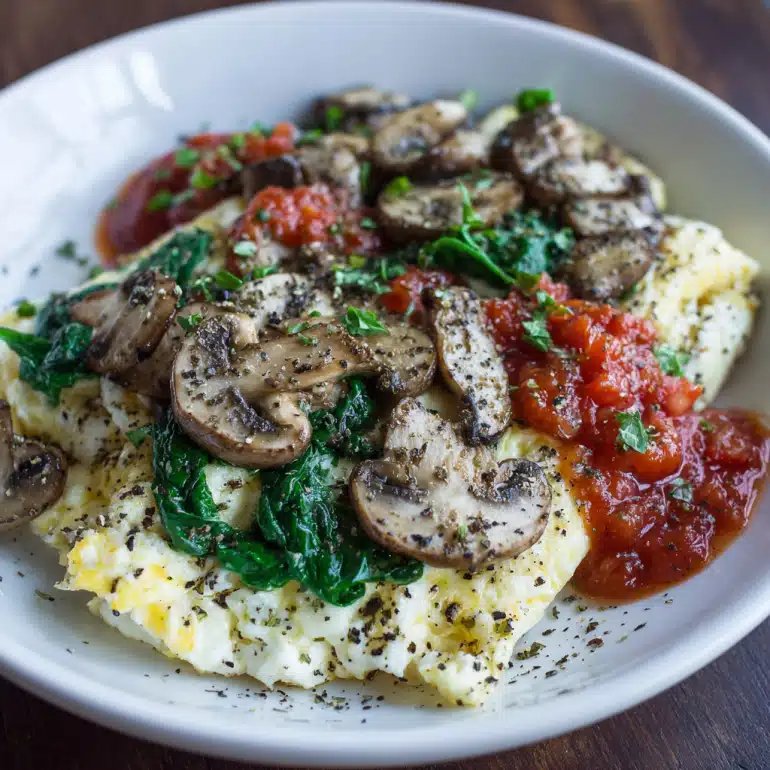
Greek Yogurt Power Bowl 245 calories, 26g protein
Ingredients:
- 3/4 cup plain Greek yogurt (0% fat)
- 1 tbsp chopped almonds
- 1/2 cup fresh berries
- 1 tsp honey
- Cinnamon
Assembly:
- Layer yogurt in bowl
- Top with berries and almonds
- Drizzle honey, sprinkle cinnamon
Weight loss advantage: The combination of protein and fiber creates lasting fullness while satisfying sweet cravings healthily.
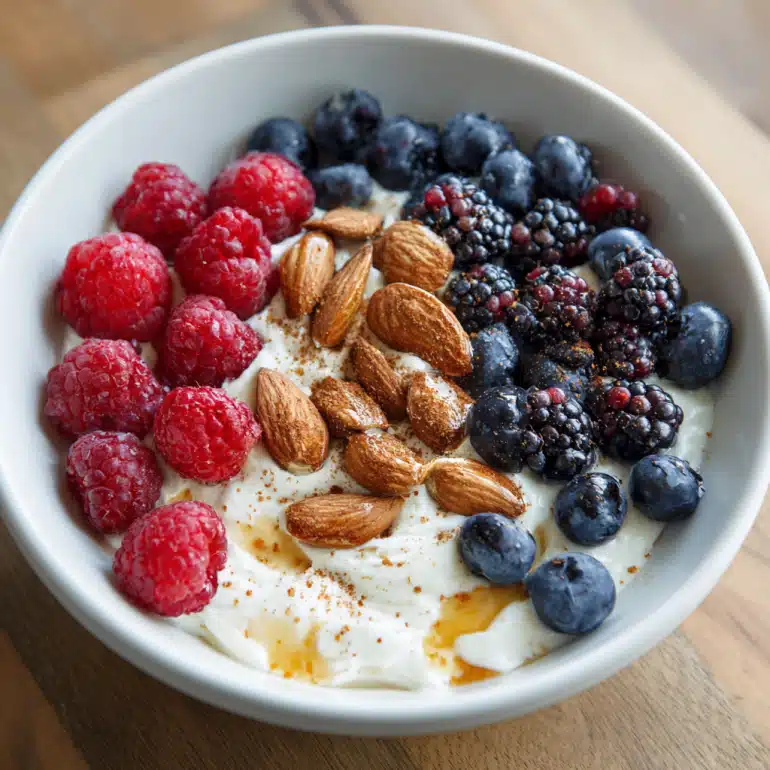
For more variety in your calorie-controlled breakfast routine, discover our collection of 25+ high-protein breakfasts under 300 calories with complete nutritional breakdowns.
300-Calorie Breakfast Options (Moderate Weight Loss)
Cottage Cheese Breakfast Bowl 295 calories, 30g protein
Ingredients:
- 1 cup low-fat cottage cheese
- 1/2 sliced banana
- 1 tbsp chopped walnuts
- 1 tsp vanilla extract
- Stevia to taste
Preparation:
- Mix cottage cheese with vanilla and stevia
- Top with banana slices and walnuts
- Serve immediately
Satiety secret: Cottage cheese provides casein protein that digests slowly, maintaining fullness for hours.
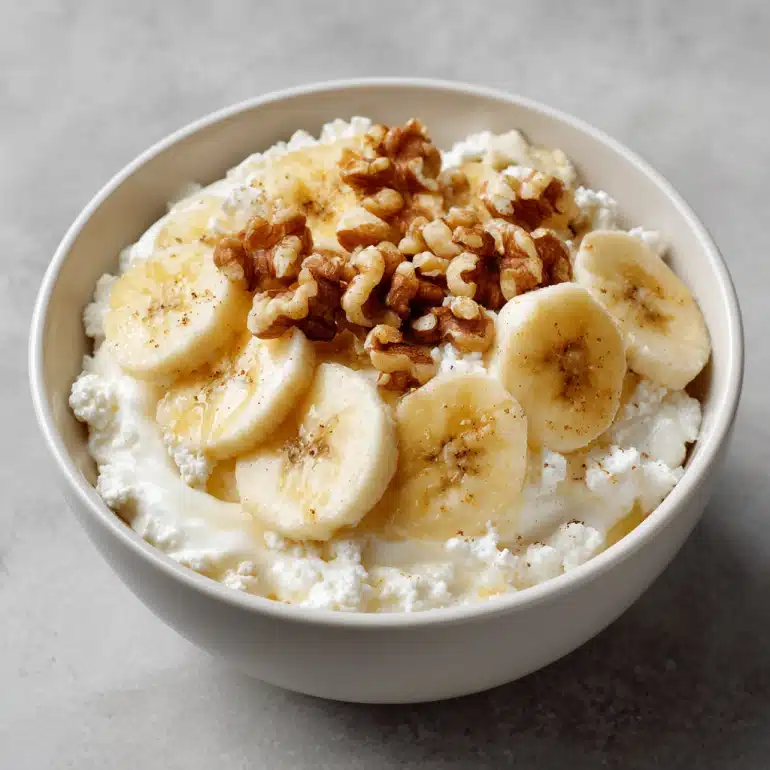
Protein Smoothie Bowl 298 calories, 32g protein
Ingredients:
- 1 scoop vanilla protein powder
- 1/2 cup unsweetened almond milk
- 1/2 frozen banana
- 1 cup spinach
- 1 tbsp almond butter
- Ice as needed
Toppings:
- Fresh berries
- 1 tbsp coconut flakes
- Chia seeds
Blending method:
- Blend all base ingredients until thick
- Pour into bowl, add toppings
- Eat with spoon for greater satisfaction

350-Calorie Breakfast Options (Maintenance/Active Individuals)
Protein Pancakes Stack 347 calories, 28g protein
Ingredients:
- 1/2 cup cottage cheese
- 2 whole eggs
- 1/4 cup oat flour
- 1 tsp baking powder
- 1 tsp vanilla extract
- Berries for topping
- 1 tbsp sugar-free syrup
Cooking instructions:
- Blend all ingredients except berries
- Cook like regular pancakes
- Stack with berries between layers
- Top with syrup

Weight loss benefit: Provides satisfaction of traditional breakfast while maintaining appropriate calories and maximizing protein.
Keto-Specific Portion Control: If you’re following a ketogenic approach, these high-protein keto breakfast bowls under 250 calories provide optimal macronutrient ratios while maintaining strict calorie control.
Troubleshooting Common Weight Loss Breakfast Challenges
Real-world implementation always involves obstacles. Here’s how to overcome the most common challenges that derail weight loss progress.
“I’m Still Hungry After Breakfast”
Problem diagnosis:
- Insufficient protein (aim for 25-30g minimum)
- Eating too quickly (slow down for satiety signals)
- Inadequate hydration before eating
- Blood sugar instability from refined carbs
Solutions:
- Increase protein by 5g and assess hunger levels
- Add fibrous vegetables for volume without calories
- Drink 16 oz water 20 minutes before eating
- Switch to complex carbohydrates (steel-cut oats vs. instant)
When hunger persists beyond 3 hours: This indicates appropriate portions. Hunger before 3 hours suggests portion or composition adjustments needed.
“I Keep Overeating Healthy Foods”
The health halo effect: Believing healthy foods don’t contribute to weight gain leads to portion distortion.
Reality check strategies:
- Track calories for 1 week to understand actual intake
- Use measuring tools temporarily to retrain portion perception
- Practice the pause technique before taking seconds
- Ask yourself: “Am I hungry or just wanting more?”
The abundance mindset: Focus on adding nutrient-dense foods rather than restricting. When you emphasize getting enough protein and vegetables, less room remains for overconsumption.
“I Don’t Have Time for Proper Portions”
Time-saving portion control strategies:
- Prep portioned containers on Sunday for grab-and-go, master the art of breakfast meal prep with our detailed Sunday breakfast prep guide featuring storage tips, timing strategies, and make-ahead recipes.
- Use single-serving packages even if more expensive per unit
- Keep backup protein bars that meet your targets
- Master 3-5 quick recipes until they become automatic
The investment principle: 5 minutes spent portioning properly saves 5 days of weight loss progress. The time investment pays exponential returns.
Short on time? Our 15-minute high-protein breakfast recipes provide quick, portion-controlled options that fit any busy schedule.
“I Feel Deprived and Want to Quit”
Deprivation psychology often stems from all-or-nothing thinking.
Psychological strategies:
- Focus on addition, not subtraction (adding protein vs. removing carbs)
- Include small amounts of foods you love within calorie targets
- Celebrate non-scale victories (energy, sleep, mood improvements)
- Remember your why – connect daily choices to larger goals
The 80/20 approach: 80% of meals follow your plan perfectly, 20% allow flexibility. This prevents the perfectionism that leads to complete abandonment.
Frequently Asked Questions
How much protein should I eat for breakfast to lose weight?
For weight loss, aim for 25-30 grams of protein at breakfast. This amount triggers optimal satiety hormones while preserving muscle mass during calorie restriction.
Individual adjustments:
Women 120-150 lbs: 25-28g protein
Women 150+ lbs: 28-32g protein
Men 160-180 lbs: 28-32g protein
Men 180+ lbs: 30-35g protein
Why this range works: Research shows 25g protein is the minimum threshold for triggering muscle protein synthesis and appetite suppression. More than 35g provides diminishing returns for weight loss while adding unnecessary calories.
Can I eat carbs for breakfast and still lose weight?
Yes, but strategic carbohydrate choices support weight loss goals better than others.
Weight loss-friendly breakfast carbs:
Steel-cut oats: High fiber, slow digestion, stable blood sugar
Berries: Low glycemic, high antioxidants, natural sweetness
Vegetables: Unlimited volume, minimal calories, maximum nutrients
Sweet potato: Complex carbs, satisfying, nutrient-dense
Carbs to limit for weight loss:
Refined cereals: Quick digestion, blood sugar spikes, increased hunger
Pastries and bagels: High calories, minimal nutrition, poor satiety
Fruit juices: Concentrated sugars without fiber benefits
The key: Pair carbohydrates with protein and fiber to slow digestion and improve satiety. A piece of fruit with Greek yogurt supports weight loss; fruit juice alone sabotages it.
Should I skip breakfast for intermittent fasting weight loss?
Controls appetite throughout the day
Prevents overeating at later meals
Supports consistent energy for exercise
Easier social integration and family meals
Intermittent fasting advantages:
Simplifies meal planning and preparation
May enhance fat oxidation during fasted periods
Reduces total eating window and opportunities for overeating
Some people naturally prefer eating later
The deciding factors: Your schedule, hunger patterns, exercise timing, and social commitments. The best approach is the one you can maintain consistently long-term.
Hybrid approach: Many successful clients eat breakfast on workout days and fast on rest days, combining both strategies.
Should I skip breakfast for intermittent fasting weight loss?
Both approaches can work for weight loss—choose based on your lifestyle and preferences.
Breakfast advantages for weight loss:
Controls appetite throughout the day
Prevents overeating at later meals
Supports consistent energy for exercise
Easier social integration and family meals
Intermittent fasting advantages:
Simplifies meal planning and preparation
May enhance fat oxidation during fasted periods
Reduces total eating window and opportunities for overeating
Some people naturally prefer eating later
The deciding factors: Your schedule, hunger patterns, exercise timing, and social commitments. The best approach is the one you can maintain consistently long-term.
Hybrid approach: Many successful clients eat breakfast on workout days and fast on rest days, combining both strategies.
How do I handle breakfast when traveling for weight loss?
Travel doesn’t have to derail weight loss progress with proper planning.
Hotel room strategies:
Pack protein powder and single-serve shaker bottles
Research grocery stores near your accommodation
Utilize hotel continental breakfast strategically (focus on eggs, yogurt, fruit)
Pack emergency protein bars that meet your targets
Restaurant breakfast navigation:
Order eggs prepared simply (scrambled, poached, hard-boiled)
Request vegetables instead of hash browns or toast
Ask for dressings and sauces on the side
Split large portions or immediately box half for later
Airport and travel day protocols:
Eat a proper breakfast before departing to avoid airport food reliance
Pack allowed travel snacks (nuts, protein bars, hard-boiled eggs)
Stay hydrated to distinguish thirst from hunger
Recovery strategy: Return to your normal routine immediately upon return. Don’t let travel become an excuse for extended deviation from your plan.
What if I’m not losing weight despite following the guidelines?
Plateau troubleshooting requires systematic evaluation of multiple factors.
First, assess adherence honestly:
Track everything you eat for 3 days including beverages and condiments
Measure portions rather than estimating for one week
Evaluate weekend eating patterns – many people are perfect Monday-Friday but overeat weekends
Consider stress and sleep impact on hunger hormones
If adherence is solid, consider these adjustments:
Reduce breakfast calories by 50 for 2 weeks and monitor progress
Increase exercise frequency or intensity to expand calorie deficit
Cycle calories throughout the week to prevent metabolic adaptation
Get comprehensive blood work to rule out hormonal issues
When to seek professional help: If you’ve been adherent for 4+ weeks without progress, consider consulting a registered dietitian or physician to rule out underlying metabolic issues.
Remember: Weight loss isn’t always linear. Some weeks show no scale movement despite fat loss due to water retention, muscle gain, or hormonal fluctuations.
Are meal replacement shakes effective for breakfast weight loss?
Meal replacement shakes can be effective for weight loss when used strategically, but they’re not magic solutions.
Advantages of meal replacement shakes:
Precise calorie and protein control eliminates guesswork
Convenience factor reduces decision fatigue
Consistent nutrition when whole food prep isn’t possible
Portion control built-in prevents overeating
Disadvantages to consider:
Less satiety than whole foods with equivalent calories
Missing chewing satisfaction that triggers fullness signals
Expense compared to whole food options
Limited long-term sustainability for most people
Best practices for shake usage:
Choose shakes with 25+ grams protein and under 300 calories Find the perfect protein powder for your needs with our detailed buyer’s guide to protein powders for busy mornings, including taste tests and nutritional comparisons.
Add fiber through spinach, chia seeds, or psyllium husk
Include healthy fats like nut butter for satiety
Use as backup option rather than daily primary choice
My recommendation: Use shakes strategically for busy mornings or travel, but build your routine around whole foods for better long-term adherence and satisfaction.
Can I eat the same breakfast every day for weight loss?
Yes, and this approach often leads to better results than constantly varying your breakfast.
Benefits of breakfast consistency:
Eliminates decision fatigue in the morning
Simplifies meal planning and prep significantly
Creates automatic portion control through repetition
Reduces chance of poor food choices when rushed
Research support: Studies show people who eat consistent breakfasts lose more weight than those who vary their morning meals daily. Consistency reduces cognitive load and improves adherence.
How to maintain variety within consistency:
Choose 3-5 go-to breakfasts and rotate weekly
Vary toppings and seasonings within the same base recipe
Change up fruits and vegetables while keeping protein source consistent
Have different options for weekdays vs. weekends
The caveat: Ensure your consistent breakfast meets all nutritional requirements. A perfectly portioned but nutritionally incomplete breakfast won’t support long-term health or weight loss.
James’s success story: “I ate the same Greek yogurt and berry bowl every morning for 4 months while losing 26 pounds. The consistency made everything else easier to manage.”
For families with children, explore our kid-approved high-protein breakfast options that make morning routines easier for everyone.
Key Takeaways: Mastering Breakfast for Sustainable Weight Loss
After working with hundreds of weight loss clients, I’ve learned that the difference between people who successfully lose weight and keep it off versus those who struggle endlessly isn’t knowledge about nutrition, it’s mastering the psychology and practicality of portion control.
The Big Three Weight Loss Transformations
1. Appetite Control Becomes Automatic: From Constant Hunger to Natural Satisfaction
When you consistently eat 25-30 grams of protein in appropriately portioned breakfasts, your appetite regulation system recalibrates. You stop fighting hunger and start trusting your body’s natural satiety signals. This isn’t about willpower, it’s about working with your biology instead of against it.
2. Energy Stabilization: From Afternoon Crashes to Sustained Performance
Strategic morning protein intake creates stable blood sugar and sustained energy that lasts 4-6 hours. You stop needing mid-morning snacks and afternoon energy fixes. This naturally reduces daily calorie intake without feeling deprived or restricted.
3. Mindset Shift: From Diet Mentality to Lifestyle Integration
Successful weight loss clients stop thinking about “being on a diet” and start viewing appropriate portions as normal eating. The goal becomes maintaining energy and health, with weight loss as a natural side effect rather than the primary focus that creates stress and restriction.
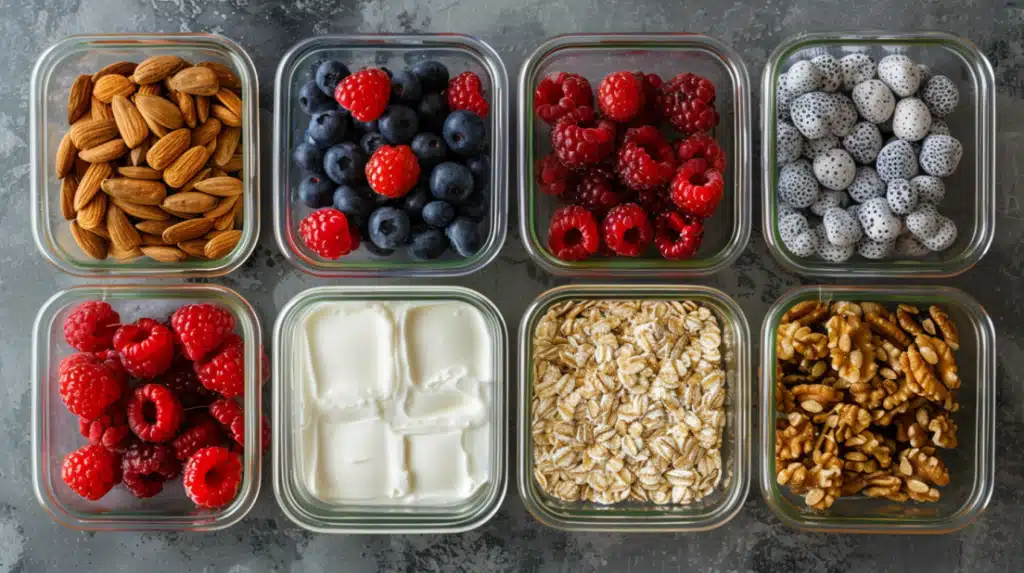
Your 30-Day Weight Loss Transformation Plan
Week 1: Foundation and Measurement
- Calculate your personal calorie and protein targets using the formulas provided
- Practice visual portion control techniques until they become second nature
- Track everything you eat to establish baseline awareness
- Focus on getting 25-30g protein at breakfast regardless of other changes
Week 2: Optimization and Habit Formation
- Implement appetite suppression strategies (protein-first eating, strategic hydration)
- Experiment with meal timing around exercise if applicable
- Address any hunger issues by adjusting protein or adding volume with vegetables
- Establish consistent wake-up and eating times
Week 3: Psychology and Sustainability
- Practice mindful eating techniques to enhance satisfaction
- Work on identity shifts from “dieter” to “person who naturally eats appropriately”
- Develop backup plans for challenging situations (travel, stress, social events)
- Focus on non-scale victories and energy improvements
Week 4: Advanced Strategies and Long-term Planning
- If weight loss has stalled, implement plateau-breaking techniques
- Fine-tune portions based on hunger, energy, and progress
- Plan for long-term maintenance and lifestyle integration
- Celebrate victories and plan continued growth
The Compound Effect of Strategic Morning Nutrition
Month 1: Consistent energy until lunch, reduced afternoon cravings, 4-8 pounds lost
Month 3: Automatic portion control, stable mood and energy, 10-15 pounds lost, clothes fitting better
Month 6: Complete appetite regulation, exercise performance improved, 15-25 pounds lost, confident food choices
Year 1: Weight loss maintained effortlessly, healthy relationship with food established, lifestyle fully integrated
These aren’t just breakfast changes, they’re foundational shifts that affect every aspect of your relationship with food and your body.
Ready to Transform Your Weight Loss Through Strategic Breakfast?
You now have the complete system for using high-protein breakfasts as your most powerful weight loss tool. The clients who succeed don’t wait for perfect conditions or motivation, they start with proper portions tomorrow morning and build momentum through consistency.
🥗 Get Your Complete Weight Loss Breakfast Toolkit
Ready to make this transformation effortless? Our comprehensive implementation guide includes:
✓ Personal calorie and protein calculator based on your specific goals
✓ Visual portion control guides you can print and reference daily
✓ 25+ weight loss-optimized breakfast recipes with exact portions
✓ Plateau-breaking strategies for when progress stalls
✓ Exercise timing templates for maximum fat burning
✓ Psychology worksheets for sustainable habit formation
✓ Access to our private community of 3,000+ successful weight loss clients
Continue Your Weight Loss Journey
Explore Related Weight Loss Resources:
- [25+ High-Protein Breakfasts Under 300 Calories] – Expand your recipe options with our complete collection of portion-controlled breakfast ideas
- [Best Protein Powder for Busy Mornings] – Choose the right supplements to support your weight loss goals when whole foods aren’t convenient
- [Meal Prep Sunday: Complete Guide to Breakfast Prep] – Master batch preparation techniques that make daily portion control effortless
Join the Weight Loss Success Community
Share your transformation: When strategic breakfast planning transforms your weight loss journey, share your story. Your success inspires others and reinforces your own positive changes.
Connect with others: Join thousands of people who’ve discovered that weight loss isn’t about perfection, it’s about consistent, strategic choices that compound over time.
Get ongoing support: Weight loss is a journey, not a destination. Connect with others who understand the challenges and celebrate the victories along the way.
Portion-Controlled Prep: Support your weight loss goals with high-protein breakfast muffins that provide pre-portioned, calorie-controlled breakfast options with 12-18 grams protein each.
One Final Weight Loss Truth
Six months from now, you’ll either have a morning routine that effortlessly supports your weight loss goals, or you’ll still be frustrated by the same stubborn pounds that brought you here today.
The difference isn’t having more willpower or motivation. It’s understanding that sustainable weight loss comes from strategic systems, not sporadic efforts. The most successful people make small, consistent improvements rather than dramatic changes they can’t maintain.
Your weight loss transformation starts with tomorrow morning’s breakfast. The body you want is built one properly portioned, protein-rich breakfast at a time.
Start tomorrow. Your future self will thank you for beginning today.
About Jennifer: I’m a certified nutrition coach (NASM-CNC) who specializes in sustainable weight loss for busy professionals. After helping over 800 clients lose weight and keep it off, I’ve learned that the most successful approaches focus on systems and psychology rather than restriction and willpower. My approach combines evidence-based nutrition science with realistic behavior change strategies that work in real life, not just on paper.

